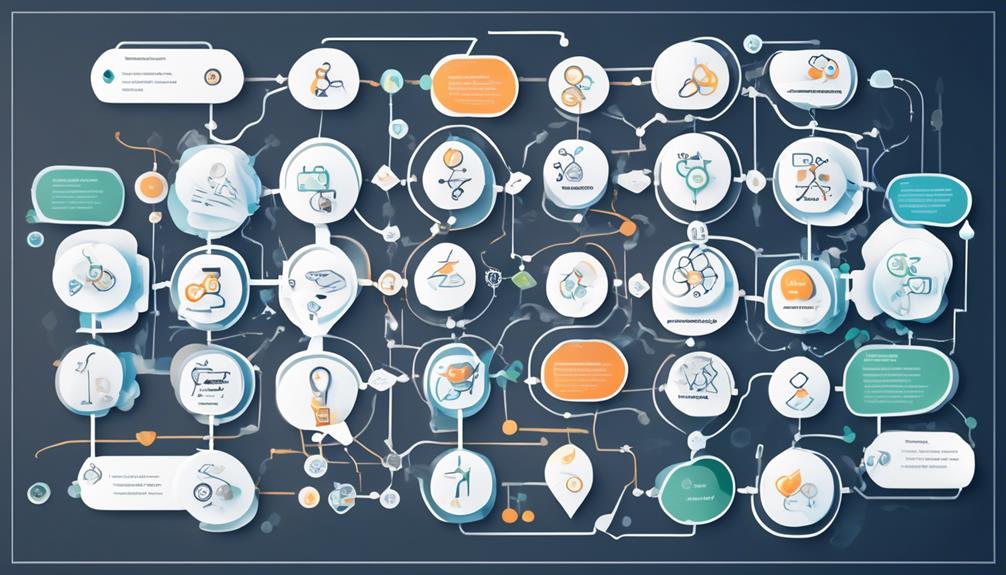We understand that assessing risks can be daunting and time-consuming, especially in the fast-paced world of software development. However, by implementing the top three software QA risk assessment strategies, we can effectively tackle potential problems before they become major obstacles. These methods are essential for ensuring the reliability and quality of software systems and are crucial for the success of any development project.
So, how exactly do these strategies work, and how can they be implemented to yield the best results?
Let's explore the top three risk assessment strategies that every software QA professional should have in their toolkit.
Key Takeaways
- Brainstorming and checklists are effective techniques for identifying risks in software QA.
- Risk evaluation and mitigation techniques, such as risk transfer, avoidance, reduction, and acceptance, are crucial for managing risks in software QA.
- Involving stakeholders in the risk assessment process enhances the accuracy and success of risk management strategies in software QA.
- Risk assessment is essential for mitigating potential issues, ensuring software reliability and quality, and proactively managing risks in software development projects.
Risk Identification Techniques
Using a combination of brainstorming, checklists, interviews, surveys, and analysis of historical data, we employ a systematic approach to identify potential software risks in our quality assurance process.
Brainstorming allows us to generate diverse sources of risks, ensuring a comprehensive assessment.
Checklists provide a structured framework to identify and categorize risks based on historical data and industry best practices.
Interviews with project stakeholders, experts, and team members yield valuable insights into potential risks and their potential impacts.
Surveys collect feedback from end users, clients, and project team members, offering a holistic view of possible risks and concerns.
Analyzing historical data and making informed assumptions help anticipate and identify potential risks.
These techniques enable us to identify risks across various dimensions, including technical, operational, and business-related aspects, ensuring a thorough risk assessment.
Risk Analysis Methods

In our software quality assurance process, we meticulously employ a range of comprehensive risk analysis methods to estimate the likelihood and severity of potential risks and determine their level of exposure.
The following are the key methods we use for risk analysis:
- Brainstorming: We conduct brainstorming sessions with project teams to identify and assess potential risks associated with the software under development.
- Checklists: We utilize predefined checklists tailored to specific project domains to ensure comprehensive coverage in identifying and mitigating potential risks before they become major issues.
- Interviews: Engaging in discussions and interviews with stakeholders, subject matter experts, and end-users helps in identifying potential risks that might've been overlooked through other methods.
- Qualitative Approaches: We employ qualitative risk analysis methods to categorize and prioritize risks based on their impact and probability, enabling effective risk management planning.
- Quantitative Approaches: Utilizing quantitative risk analysis helps us in assigning numerical values to risks, facilitating a more precise understanding of their potential impact on the project.
Risk Evaluation Strategies
Employing a comprehensive risk evaluation framework allows us to make informed decisions regarding which risks require immediate attention and how best to address them based on predefined criteria.
Risk evaluation strategies involve assessing the identified risks to determine their significance and impact on the software testing project.
The QA team utilizes various mitigation techniques to address these risks, such as risk transfer, risk avoidance, risk reduction, and risk acceptance.
Additionally, implementing metrics for risk assessment enables the team to measure the effectiveness of the mitigation strategies and track the progress of risk management efforts.
By prioritizing risks based on their potential impact and likelihood of occurrence, the QA team can allocate resources efficiently and focus on addressing the most critical issues.
Furthermore, involving stakeholders in the risk evaluation process ensures that their preferences and concerns are considered when determining the most suitable risk management strategies.
Ultimately, effective risk evaluation strategies support the overall success of the software testing project by proactively addressing potential issues and minimizing their adverse effects.
Frequently Asked Questions
How Do You Mitigate Risk in Qa?
We mitigate risk in QA by engaging with stakeholders. We prioritize potential risks based on criticalness of the system, regulatory requirements, and business objectives. Furthermore, we communicate responsibilities, monitor progress, and implement risk mitigation strategies. These strategies include preventive measures, contingency plans, risk avoidance, and risk reduction.
We continuously improve these strategies based on lessons learned. Additionally, we prioritize test cases based on the level of risk associated with each software requirement or feature.
How Do You Assess Risk in Software Testing?
We assess risk in software testing by:
- Identifying potential sources of risks
- Analyzing their likelihood and severity
- Evaluating which risks need to be addressed
- Monitoring their status and performance
This involves methods such as:
- Brainstorming
- Checklists
- Interviews
- Surveys
- Historical data
These methods are used to prioritize risks based on probability and impact. By doing so, we can:
- Create a risk response plan
- Improve software quality
- Optimize test scope
- Increase stakeholder confidence
- Support decision-making.
What Are the 4 Risk Assessment Techniques?
The 4 risk assessment techniques involve risk identification, analysis, evaluation, and monitoring.
We use methods like brainstorming, checklists, interviews, surveys, historical data, and expert opinions to find and list potential software risks.
Then, we estimate the likelihood and severity of each risk to prioritize and determine exposure.
After that, we decide which risks need to be addressed based on cost, benefit, feasibility, urgency, and stakeholder preferences.
Which Is Best Risk Based Testing Techniques?
The best risk-based testing techniques vary depending on the specific context and objectives of the software project. It's essential to consider factors such as the nature of the software, the potential impact of failures, and the preferences of stakeholders.
Techniques like failure mode and effect analysis (FMEA), risk-based testing, and exploratory testing can be valuable in identifying and mitigating risks in software testing.
Tailoring the approach to the unique characteristics of the project is crucial for effective risk assessment.
Conclusion
In conclusion, implementing effective risk assessment strategies is crucial for ensuring the quality and reliability of software systems.
By identifying, analyzing, and evaluating potential risks, we can proactively address and mitigate them, ultimately reducing the likelihood of costly errors and failures.
As the saying goes, 'an ounce of prevention is worth a pound of cure,' and these strategies provide the necessary foundation for a robust and resilient software QA process.








